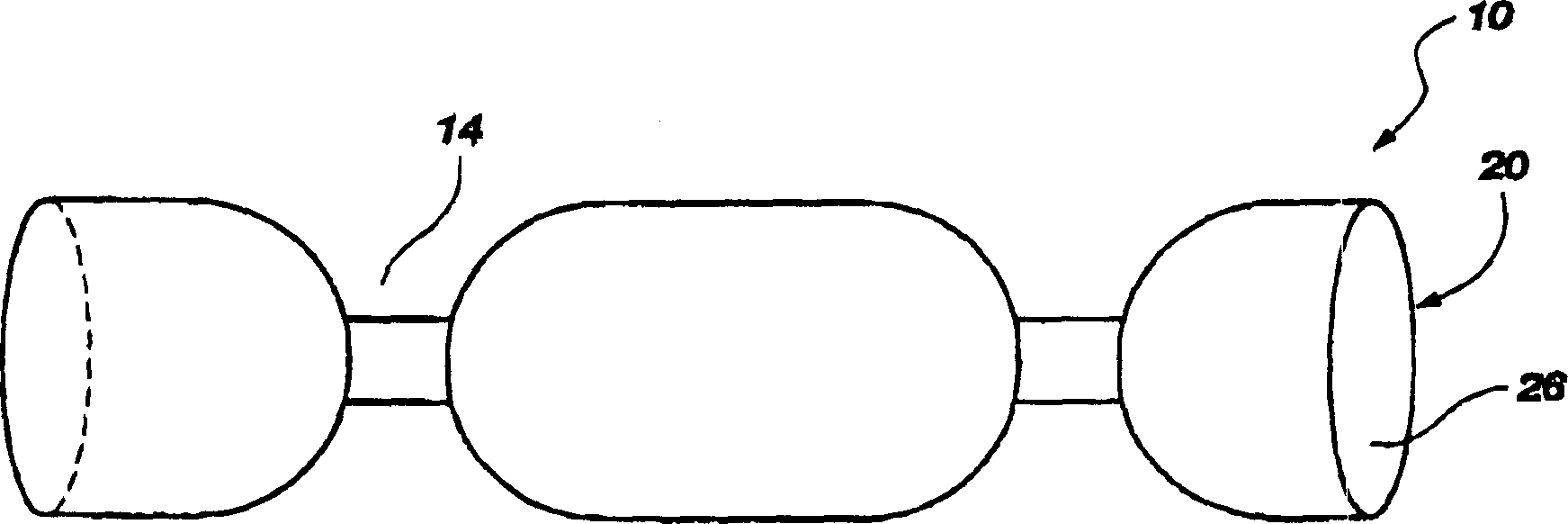Edible thermoplastic and nutritious segmented pet chew
A thermoplastic, chewable technology, applied in the field of pet chews, can solve the problems of lack of nutritional value, unable to replace or supplement pet's daily diet, etc.
- Summary
- Abstract
- Description
- Claims
- Application Information
AI Technical Summary
Problems solved by technology
Method used
Image
Examples
Embodiment 1
[0081] Physical Properties of Edible Thermoplastics
[0082] Edible thermoplastics are made from combinations of vegetable protein and proteinaceous material compositions of animal origin with starch or carbohydrates. The ingredients were premixed in a high speed mixer (Henschel Mixers America, Inc., FM10 Heater Mixer) at room temperature for 3-4 minutes at mixer speed 1800 rpm. The ingredients were further processed using a Leistritz Micro-18 co-rotating twin-screw extruder with a 6 inch sheet die with 6 barrel zones.
[0083] Each zone has the following temperature profile: Zone 1 is about 90°C, Zone 2 is about 90-100°C, Zone 3 is about 110°C, Zone 4 is about 110°C, Zone 5 is about 90°C, and Zone 6 is about 85°C. Die temperature was about 80C. The screw speed was set at about 150 rpm. Die pressure was about 160-880 psi.
[0084] After extruding the sheets, ASTM standard test specimens were processed according to the American Society for Testing and Materials (ASTM D638-8...
Embodiment 2
[0109] Effects of starches, carbohydrates, and modifiers on the physical properties of thermoplastics
[0110] Table 2 presents the effect of starch, carbohydrates, and modifiers on the physical properties of edible thermoplastics. The composition and preparation method of the test sample are the same as in Example 1. The results are given in Table 2.
[0111] Samples 1 and 2 show that the combination of soy protein concentrate and wheat gluten with carbohydrates and wheat flour has higher tensile strength and Young's modulus than the combination of soy protein concentrate and wheat gluten with corn starch.
[0112] In sample 3, 5.3 wt.% sodium alginate was added as a modifier. The results showed that the tensile strength and Young's modulus were increased by adding sodium alginate.
[0113] In sample 4, carbohydrate gum (nutricol) was added as a modifier in an amount of 2.7 wt.% based on the total weight of sample 1. The results showed that the tensile strength and Youn...
Embodiment 3
[0121] The Effect of Moisture Content on the Physical Properties of Edible Thermoplastics
[0122] Table 3 presents the effect of moisture content on the physical properties of edible thermoplastics. Physical properties such as tensile strength and Young's modulus are increased by decreasing moisture content. The percent elongation decreases with decreasing moisture content in the test specimen.
[0123] Additionally, moisture content is important to the care and protection of edible thermoplastics. This example demonstrates that a moisture content of about 8-12 wt.% provides optimal physical properties while preventing spoilage.
[0124] table 3
[0125] Sample No. Composition 1 1 2 3 Soy protein concentrate (VF) 15.55 same same wheat gluten 15.55 same same gelatin 8.5 same same cornstarch 25.4 same same garlic powder 1.1 same same onion powder 1.1 same same lecithin 0.6 same same turkey grits 2.8 sam...
PUM
| Property | Measurement | Unit |
|---|---|---|
| density | aaaaa | aaaaa |
| tensile strength | aaaaa | aaaaa |
| tensile strength | aaaaa | aaaaa |
Abstract
Description
Claims
Application Information
 Login to View More
Login to View More - R&D
- Intellectual Property
- Life Sciences
- Materials
- Tech Scout
- Unparalleled Data Quality
- Higher Quality Content
- 60% Fewer Hallucinations
Browse by: Latest US Patents, China's latest patents, Technical Efficacy Thesaurus, Application Domain, Technology Topic, Popular Technical Reports.
© 2025 PatSnap. All rights reserved.Legal|Privacy policy|Modern Slavery Act Transparency Statement|Sitemap|About US| Contact US: help@patsnap.com



